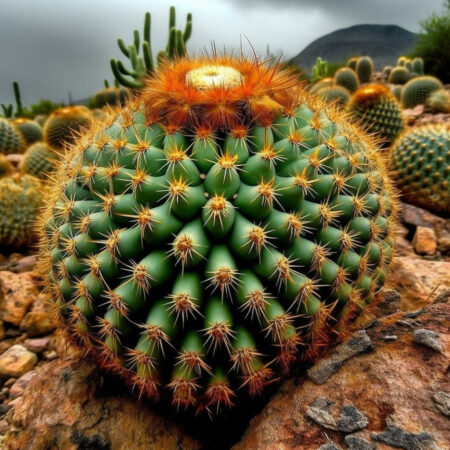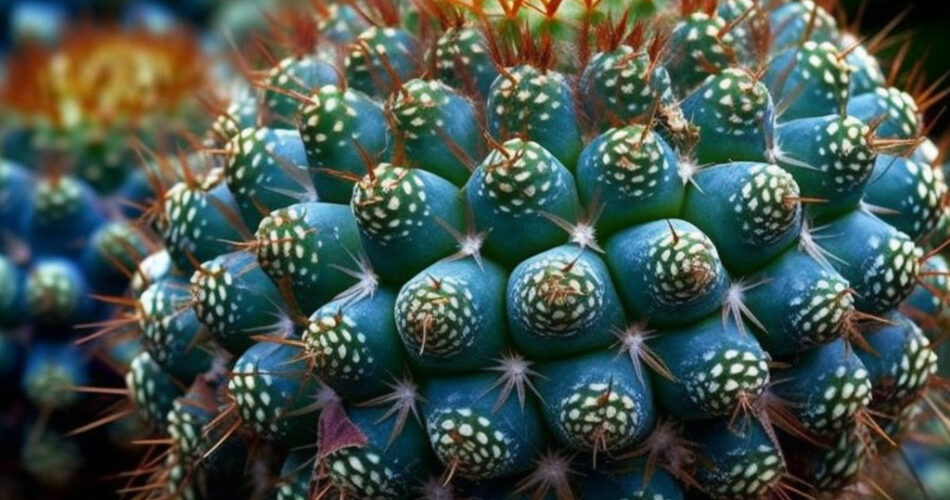Key Takeaways:
- These cacti are native to Brazil and known for their unique appearance and stunning blooms.
- Arrojadoa cacti have cylindrical or conical stems with spines and can reach impressive heights.
- Arrojadoa cactus produce trumpet-shaped flowers in shades of pink, red, and white.
- To care for this cacti, provide well-draining soil, warm temperatures, and bright, indirect sunlight.
- Proper watering, avoiding overwatering, and preventing pests and diseases are vital for its health.
- Propagation methods for Arrojadoa cacti include stem cuttings, grafting, and offsets.
1. The Fascinating World of Arrojadoa
1.1. Introduction to Arrojadoa Cactus
Arrojadoa is a genus of cacti that belongs to the family Cactaceae. Named after Portuguese botanist João Barbosa Rodrigues, Arrojadoa cactuses are native to the rocky landscapes and arid regions of Brazil. These unique cacti are admired by collectors and cactus enthusiasts for their unusual appearance and stunning blooms.
Arrojadoa cacti are characterized by their cylindrical or conical stems that grow upwards and have numerous ribs. The stems are covered in spines of varying lengths and colors, which provide protection against predators. With age, these cacti can reach impressive heights of up to 15 feet, making them a remarkable addition to any cactus collection.
1.2. Diversity and Types of Arrojadoa Cacti
The Arrojadoa genus consists of several species, each with its own unique characteristics and appearances. Some of the most popular species include Arrojadoa dinae, Arrojadoa rhodantha, Arrojadoa bahiensis, and Arrojadoa penicillata.
Arrojadoa dinae is known for its dazzling pink to red flowers and can grow up to 12 feet tall. Arrojadoa rhodantha, also referred to as the “Coral Cactus,” displays bright red blooms and is often treasured for its ornamental value. Arrojadoa bahiensis and Arrojadoa penicillata are both characterized by their creamy-white flowers and can reach heights of around 10 feet.
1.3. Uniqueness and Characteristics
What sets this cacti apart from other cactus genera is their fascinating floral displays. These cacti produce stunning trumpet-shaped flowers in various shades of pink, red, and white, which bloom from the areoles on the stems. The flowers are often fragrant and attract pollinators such as bees and butterflies.
In addition to their striking blooms, these also exhibit interesting growth patterns. When young, they often have a more globular or columnar shape, which gradually elongates as they mature. The stems can branch out, creating a beautiful cluster of cacti in pots or gardens.
2. Caring for Arrojadoa Cacti: A Complete Guide
2.1. Understanding the Environmental Needs
Arrojadoa cacti are native to the arid regions of Brazil and thrive in similar environmental conditions. To ensure your Arrojadoa cacti flourish, it’s important to provide them with well-draining soil, as they are susceptible to root rot. A mix of cactus potting mix and perlite or pumice is ideal.
In terms of temperature, these cactuses prefer warm climates. They can tolerate temperatures as low as 50°F (10°C) but thrive best when temperatures range between 70°F to 90°F (21°C to 32°C). It’s important to protect them from frost and extreme temperature fluctuations.
2.2. Watering and Moisture Requirements for Healthy Arrojadoa Cactus
Proper watering is crucial for the health of your cacti. During the growing season, which typically spans from spring to early fall, water your cacti thoroughly whenever the top inch of soil feels dry. Allow the excess water to drain out completely, as stagnant water can lead to root rot.
During the winter months, when Arrojadoa cacti enter a dormant period, reduce watering and only moisten the soil occasionally. It’s important to strike a balance and avoid overwatering, as these cacti are adapted to arid conditions.
2.3. The Perfect Light and Temperature Conditions
This cactus thrive in bright, indirect sunlight. Place them near a south-facing window or provide filtered sunlight if growing them outdoors. Avoid exposing them to intense, direct sunlight for prolonged periods as it can scorch the delicate stems. Gradually acclimate the cacti to brighter light to prevent sunburn.
In terms of humidity, this cacti can tolerate low to moderate levels. However, it’s important to ensure good airflow around the plants to prevent excessive moisture buildup, which can lead to fungal diseases. If you live in a humid climate, consider using a fan to increase air circulation around your cacti.

3. Protecting Arrojadoa Cacti from Common Pests and Diseases
3.1. Identifying and Treating Pests that Affect Arrojadoa Cacti
While these cactuses are generally resilient, they can still fall victim to common cactus pests such as mealybugs, scale insects, and spider mites. Regularly inspect your plants for any signs of infestation, including white cottony spots, sticky residue, or webbing on the stems and foliage.
If you notice any pests, promptly isolate the affected plants to prevent further spread. Treat the infested cacti with a mild insecticidal soap or horticultural oil, following the instructions carefully. Additionally, gently wiping the stems and spines with a cotton swab dipped in rubbing alcohol can also help eradicate pests.
3.2. Preventing and Managing Common Diseases
Arrojadoa are generally resistant to diseases when provided with suitable growing conditions. However, they can still be susceptible to fungal diseases such as root rot and stem rot if overwatered or exposed to prolonged high humidity.
To prevent fungal diseases, ensure proper soil drainage and avoid overwatering your cacti. If you notice any signs of rot, such as soft or discolored stems, take immediate action by removing the affected parts and applying a fungicide formulated for cacti.
3.3. Best Practices for Maintaining the Health of This Popular Cacti
To maintain the overall health and vitality of your Arrojadoa, it’s essential to follow these best practices:
- Regularly inspect your cacti for any signs of pests, diseases, or stress.
- Provide proper airflow by spacing out your plants and using fans if necessary.
- Monitor the moisture levels in the soil and adjust watering accordingly.
- Periodically clean the cacti’s stems and spines to remove dust and debris.
- Fertilize sparingly during the growing season using a balanced, water-soluble cactus fertilizer.
- Refrain from repotting your cactus unless necessary, as they prefer snug conditions.
4. Propagation and Reproduction Techniques
4.1. Understanding the Reproduction Cycle
Arrojadoa reproduce through both sexual and vegetative methods. In their natural habitat, they rely on pollinators to fertilize their flowers and produce fruit containing seeds. However, propagation through seeds can be a lengthy process and requires specific conditions to be successful.
Vegetative propagation, such as stem cuttings, offers a more reliable and quicker way to propagate. This method involves taking a healthy stem cutting from a mature plant and allowing it to callus before planting it in a suitable potting mix.
4.2. Propagation Methods: Choosing the Right Approach
When propagating Arrojadoa cactus, you have a few options to choose from:
- Stem cuttings: Take a stem cutting from a mature plant and let it dry and callus before planting it in well-draining soil.
- Grafting: Combine a stem cutting from Arrojadoa cactus with the rootstock of a different cactus species to enhance growth and resilience.
- Offsets: Some species produce offsets or “pups” that can be carefully detached and planted individually.
4.3. Tips and Tricks for Successful Arrojadoa Cacti Propagation
To increase your chances of successful propagation, follow these tips and tricks:
- Select a healthy parent plant with no signs of pests, diseases, or stress.
- Use a sterile cutting tool to prevent the transfer of pathogens.
- Allow the cuttings to callus for several days before planting to minimize the risk of rotting.
- Provide a warm and partially shaded environment for the newly planted cuttings to encourage root development.
- Be patient, as it may take a few weeks to several months for new roots to emerge, depending on the method chosen.
In conclusion, Arrojadoa cacti are a captivating genus of cacti known for their unique appearance and stunning blooms. By understanding their environmental needs, providing proper care, and protecting them from pests and diseases, you can ensure the health and vitality of your cacti. Additionally, learning the various propagation methods allows you to expand your collection and share the beauty of these exquisite cacti with others.
FAQ
Question: Are Arrojadoa cacti native to Brazil?
Answer: Yes, Arrojadoa cacti are native to the rocky landscapes and arid regions of Brazil.
Question: What is the unique characteristic of Arrojadoa cacti?
Answer: Arrojadoa cacti are known for their fascinating floral displays. They produce stunning trumpet-shaped flowers in shades of pink, red, and white.
Question: What are the ideal temperature conditions?
Answer: Arrojadoa cacti prefer warm climates and thrive best when temperatures range between 70°F to 90°F (21°C to 32°C). It’s important to protect them from frost and extreme temperature fluctuations.
Question: How often should I water my Arrojadoa cacti?
Answer: During the growing season, water your cactus thoroughly whenever the top inch of soil feels dry. Allow the excess water to drain out completely. In winter, reduce watering and only moisten the soil occasionally.
Question: Can Arrojadoa cacti tolerate low humidity?
Answer: Yes, this cactus can tolerate low to moderate levels of humidity. However, it’s important to ensure good airflow around the plants to prevent excessive moisture buildup, which can lead to fungal diseases.
Question: What are the common pests that affect it?
Answer: Common pests that can affect it include mealybugs, scale insects, and spider mites. Regularly inspect your plants for signs of infestation and take prompt action if necessary.
Question: How can I propagate Arrojadoa cacti?
Answer: Arrojadoa can be propagated through stem cuttings, grafting, and offsets. Stem cuttings are the most common method, where a healthy stem cutting is allowed to callus before planting it in well-draining soil.
Question: How long does it take for new roots to develop during propagation?
Answer: The time it takes for new roots to develop during propagation can vary. It may take a few weeks to several months, depending on the method chosen and the environmental conditions provided.




Comments